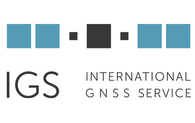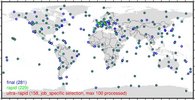
As one of the analysis centers of the International GNSS Service (IGS), we process thousands of GNSS observations daily to derive precise station coordinates, satellite orbits, satellite clock corrections and Earth rotation parameters. In line with the current IGS product policy, we provide geodetic products in ultra-rapid (latency 3-9h), rapid (latency (1 day) and final (latency two weeks) mode. GPS, GLONASS and Galileo are currently processed.
All three processing lines follow the same strategy. Based on a well-defined selection of IGS stations (see Figure 1), a least squares adjustment is used to derive the unknowns to be determined. Within this network adjustment, the satellite orbits and the clock corrections (i.e. the deviation of the satellite clock with respect to the GPS time) are determined. Phase ambiguities are fixed for GPS and Galileo observations. The generation of the IGS products follows the least squares adjustment, the respective product range depends on the IGS guidelines.
The ultra-rapid line only provides orbits (15-minute sampling) and clock corrections (5-minute sampling), but includes predictions for the next 24 hours. These products are of interest for real-time or near real-time applications. The rapid line also provides orbit and clock corrections, but also earth rotation parameters. The most accurate results are derived weekly (final). Here the satellite orbits are determined by concatenating the daily arcs to three-day arcs, which makes it possible to minimize the orbit jumps at the daily boundaries. Satellite clocks are supplied with 30-second sampling. Earth rotation parameters and station coordinates are also provided in ERP or SINEX format. All products are delivered in the current reference frame (i.e. IGS20 since November 27, 2022, previously IGb14). A detailed description of our GNSS processing strategy can be found in the GFZ Analysis Center Notes.
The calculations are performed with the EPOS.P8 software developed at GFZ, which complies with current geodetic standards. The high quality of our products is ensured by the comparisons and combinations performed by the IGS coordinator of the analysis centers. Recent information about the processing are provided in the annual technical reports of the IGS available at igs.org/tech-report/.
GFZ products (GFZ ISDC):
https://isdc.gfz-potsdam.de/gnss-products/
- final: Männel, B., Brandt, A., Nischan, T., Brack, A., Sakic, P., Bradke, M. (2020): GFZ final product series for the International GNSS Service (IGS). GFZ Data Services. https://doi.org/10.5880/GFZ.1.1.2020.002
- rapid: Männel, B., Brandt, A., Nischan, T., Brack, A., Sakic, P., Bradke, M. (2020): GFZ rapid product series for the IGS. GFZ Data Services. https://doi.org/10.5880/GFZ.1.1.2020.003
- ultra-rapid: Männel, B., Brandt, A., Nischan, T., Brack, A., Sakic, P., Bradke, M. (2020): GFZ ultra-rapid product series for the IGS. GFZ Data Services. https://doi.org/10.5880/GFZ.1.1.2020.004




